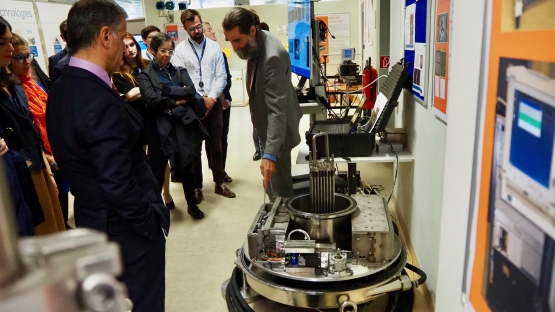At an event on the sidelines of the IAEA General Conference today, the Passive Gamma Emission Tomography (PGET) system was presented to delegates. PGET is one of a number of systems recently introduced by the IAEA to help verify the peaceful use of nuclear material - an activity known as safeguards.
The PGET system enables the IAEA to verify the number of fuel rods in spent nuclear fuel assemblies, generated in power plants and stored in cooling ponds. While spent fuel is no longer useful for generating electricity, it contains nuclear material that could potentially be diverted for use in nuclear weapons. To verify that spent fuel is not diverted, the PGET equipment is lowered into a spent nuclear fuel pond to perform three simultaneous measurements: gross neutron and gamma ray counting, gamma ray spectrometry and tomographic imaging of the positions of spent fuel rods. In about five minutes, a safeguards inspector can collect this data, process it and analyze the results. To verify irradiated material, PGET is the latest and most powerful system in the nuclear safeguards inspector’s in-field toolkit.
“Field tests of the PGET system have demonstrated its capability to detect even a single missing rod from among the thousands of assemblies stored in spent fuel ponds, and for a variety of commercial light-water reactor fuel types,” said Tim White, a Non-Destructive Assay Expert at the IAEA. “In addition, inspectors can now verify fuel rods within closed containers.”
This technology has the potential to significantly improve the effectiveness of safeguards verification for the steadily increasing inventories of spent nuclear fuel worldwide. The presentation highlighted the recent advances in tomographic image reconstruction using data from PGET. For example, the new software automatically confirms the number of fuel rods present, and reports this information to the inspector who compares it to the State declaration of nuclear material.
“Developing PGET has taken decades of effort and close collaboration with several Member States and industrial suppliers,” said White. “Also, the system performance will continue to improve by leveraging hardware and software from other disciplines.” To support this development, the most recent IAEA Safeguards technology challenge sought submissions from the public to enhance the software used to analyze PGET data. The IAEA regularly runs such public challenges to seek new solutions to further enhance safeguards implementation.
“The demo was very beneficial and very educational,” said Saeed Alamoudi, Director, Nuclear Regulatory Sector, Nuclear and Radiological Regulatory Commission, Saudi Arabia. “I was impressed to see the details of how PGET is used to verify missing fuel rods and the mechanism to verify the declared accountancy of nuclear material.”




